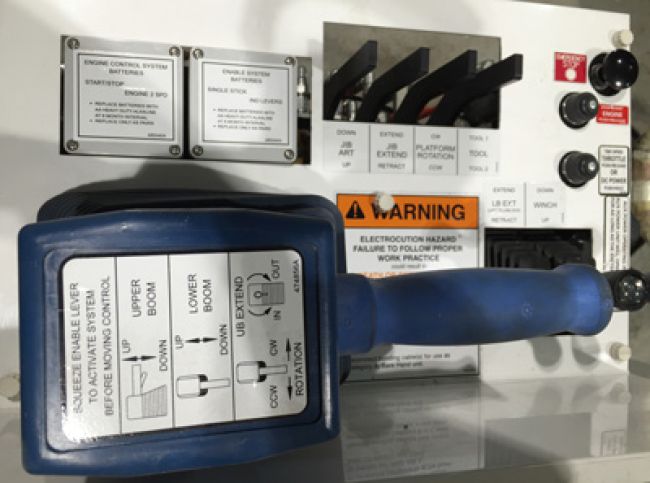
Important Considerations When Spec’ing Lift Controls
The lift control panel on an aerial device is an important element for effectively running the unit, enabling the working platform to be propelled into a desired location. Similar to how a steering wheel gives a truck-mounted aerial device mobility to get to and from a job site, the lift control panel gives the machine’s operators the ability to quickly and easily position the platform into the work area.
But because the operator control station is relatively small, it’s not always top of mind when new units are being spec’d. Given the importance of lift controls on aerial devices, however, following are some insights to consider when spec’ing them.
The foundation of every control panel is the ability for operators to use it to control the aerial device’s vertical longitudinal (or extend-and-retract) and rotational (or side-to-side) movements. For instance, most aerial device control stations are equipped with a single joystick. The joystick is designed to give operators control of the machine’s boom functions from one handle. “A common industry standard on an aerial device’s lift control panel is a three-function joystick,” said Dan Brenden, director of engineering for Terex Utilities (www.terex.com/utilities). “This type of joystick allows operators to move the individual booms up and down, as well as to rotate the unit.”
Four-function single joysticks are available as an option. This type of joystick enables operators to extend and retract the boom on articulating models, or it can operate elevator sections, if equipped, giving users even more control and functionality from one joystick. According to Brenden, “Terex uses similar single joystick designs across its entire aerial device product line, keeping uniformity within the brand, so from the smallest to largest machines, all controls function the same for the operator.”
Control stations may also include the ability to control platform/basket movements. This feature elevates the platform, regardless of the boom’s position, allowing operators to gain several feet of working height to access hard-to-reach work areas. The operator’s ability to control the speed of the functions can also be located on the control station. Brenden mentioned that Terex offers a two-speed control option.
Air-operated chassis engine stop and start plungers are an option at the platform, allowing operators to quickly and easily turn the chassis engine on or off. Control stations are also equipped with an enable lever, which provides operators protection against inadvertent operation. According to Brenden, the enable lever must be actuated, in combination with the lift control movement, before any platform movement is allowed.
The type and arrangement of an aerial device’s lift control panels can vary from platform to platform, and from manufacturer to manufacturer. Additional functionality and control options on a lift control panel will depend on the machine’s specific options. “For example, if the machine has a basic jib, the lift controls will include functions for winch and jib articulation,” Brenden said. “If the machine is equipped with a hydraulic extend jib, that adds the need for more controls. The more options an aerial device has, the more controls needed.”
About the Author: Amber Reed is a consultant for Signature Style PR + Marketing, based in Huntersville, N.C.
*****
Safety Features on Lift Controls
An aerial device’s lift functions are controlled by the operator, either in the platform or at the control station at the base of the unit, said Dan Brenden, director of engineering for Terex Utilities. All aerial devices are fitted with controls in both locations.
Safety is of utmost importance when operating an aerial device. Every device is outfitted with a lower control station at the base of the machine that overrides the platform controls. This offers several benefits, including the ability to lower the lift if an operator, working at height, becomes unable to operate the controls. There is also a control option that allows the operator and unit to be safely lowered in the event of an equipment power failure.
Nonmetallic control handles are another standard safety feature on a control panel. The single joystick is dielectrically tested and may provide limited secondary protection between the metallic components of the boom tip and handle. “It is important to note that this handle is not rated for electrical protection, although it may provide limited secondary protection from incidental contact,” Brenden said. “It is not intended to replace safe work practices or primary protection, such as maintaining distance, cover-up and personal protection equipment.”

